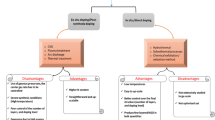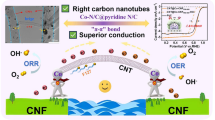Abstract
Graphene oxide (GO) was synthesized by the modified Hummers method and then reduced with NaBH4 to form RGO with a regular layered structure. The graphene oxide is benzenesulfonated to obtain a functionalized graphene material (RGO-BS). The benzenesulfonated polyaniline/RGO composite (PANI/RGO-BS) was prepared by adsorption double oxidation method using RGO as template. Some physical characterization methods (X-ray diffraction, Fourier-transform infrared spectroscopy, and scanning electron microscopy) were used to analyze the morphology and crystallinity of the composite. The electrochemical properties were characterized by cyclic voltammetry, impedance spectroscopy, galvanostatic charge/discharge, and rate capability. The initial discharge specific capacities of oxidized PANI/RGO-BS and reduced PANI/RGO-BS were 165.4 and 176 mAh/g. After 100 cycles, the capacity retention rates were 92.6% and 96%, the coulombic efficiency of the battery is close to 100%. These results indicate functionalized composite has exciting potentials for the cathode material of lithium-ion battery.










Similar content being viewed by others
References
Shirakawa H, Louis EJ, Macdiarmid AG et al (1977) Synthesis of electrically conducting organic polymers: halogen derivatives of polyacetylene, (CH)x. J Chem Soc, Chem Commun 16:578–580
Yumoto Y, Yoshimura S (1986) Synthesis and electrical properties of a new conducting polythiophene prepared by electrochemical polymerization of α-terthienyl. Synth Met 13:185–191
Kanazawa KK, Diaz AF, Gill WD et al (1979) Polypyrrole: an electrochemically synthesized conducting organic polymer. Synth Met 1:329–336
Macdiarmid AG, Chiang J-C, Huang W et al (1985) Polyaniline: protonic acid doping to the metallic regime. Mol Cryst Liq Cryst 125:309–318
Macdiarmid AG, Chiang J-C, Halpern M et al (1985) “Polyaniline”: interconversion of metallic and insulating forms. Mol Cryst Liq Cryst 121:173–180
Macdiarmid AG, Shao-Lin M, Somasiri NLD et al (1985) Electrochemical characteristics of “polyaniline” cathodes and anodes in aqueous electrolytes. Mol Cryst Liq Cryst 121:187–190
Wang C, Guo Z, Hong R, Gao J, Guo Y, Gu C (2018) A novel method for synthesis of polyaniline and its application for catalytic degradation of atrazine in a Fenton-like system. Chemosphere 197:576–584
Mohanraju K, Sreejith V, Ananth R, Cindrella L (2015) Enhanced electrocatalytic activity of PANI and CoFe2O4/PANI composite supported on graphene for fuel cell applications. J Power Sources 284:383–391
Ismail MM, Rafeeq SN, Sulaiman JMA, Mandal A (2018) Electromagnetic interference shielding and microwave absorption properties of cobalt ferrite CoFe2O4/polyaniline composite. Appl Phys A 124:380
Rose A, Guru Prasad K, Sakthivel T, et al (2018) Electrochemical analysis of graphene oxide/polyaniline/polyvinyl alcohol composite nanofibers for supercapacitor applications. Appl Surf Sci 499:551–557
Hong XD, Lu YG, Li SL et al (2019) Carbon foam@reduced graphene oxide scaffold grown with polyaniline nanofibers for high performance symmetric supercapacitor. Electrochim Acta 294:376–382
Ding ZW, Zhao DL, Yao RR, et al (2018) Polyaniline@spherical ordered mesoporous carbon/sulfur nanocomposites for high-performance lithium-sulfur batteries. Int J Hydrogen Energy 43:10502–10510
Wei J, Huang F, Wang S, Zhou L, Xin Y, Jin P, Cai Z, Yin Z, Pang Q, Zhang JZ (2018) Highly stable and efficient hybrid perovskite solar cells improved with conductive polyanilines. Mater Res Bull 106:35–39
Zhang D, Wang D, Zong X, et al (2018) High-performance QCM humidity sensor based on graphene oxide/tin oxide/polyaniline ternary nanocomposite prepared by in-situ oxidative polymerization method. Sens Actuators B Chemical 262:531–541
Sha R, Komori K, Badhulika S (2017) Graphene–polyaniline composite based ultra-sensitive electrochemical sensor for non-enzymatic detection of urea. Electrochim Acta 233:44–51
Wu X, Wu Y, Dong H, Zhao J, Wang C, Zhou S, Lu J, Yan Y, Li H (2018) Accelerating the design of molecularly imprinted nanocomposite membranes modified by Au@polyaniline for selective enrichment and separation of ibuprofen. Appl Surf Sci 428:555–565
Zhu A, Wang H, Sun S, Zhang C (2018) The synthesis and antistatic, anticorrosive properties of polyaniline composite coating. Prog Org Coat 122:270–279
Fergus JW (2010) Recent developments in cathode materials for lithium ion batteries. J. Power Sources 195:939–954
Zhang WJ (2011) Structure and performance of LiFePO4 cathode materials: a review. J. Power Sources 196:2962–2970
Yi TF, Li XY, Liu H, Shu J, Zhu YR, Zhu RS (2012) Recent developments in the doping and surface modification of LiFePO4 as cathode material for power lithium ion battery. Ionics 18:529–539
Wang Z, Liu L, Chen L et al (2002) Structural and electrochemical characterizations of surface-modified LiCoO2 cathode materials for Li-ion batteries. Solid State Ionics 148:335–342
Lee MJ, Lee S, Oh P, Kim Y, Cho J (2014) High performance LiMn2O4, cathode materials grown with epitaxial layered nanostructure for Li-ion batteries. Nano Lett 14:993–999
Cui P, Jia Z, Li L, He T (2011) Preparation and characteristics of Sb-doped LiNiO2 cathode materials for Li-ion batteries. J Phys Chem Solids 72:899–903
Liu Y, Zhou Y, Zhang S, Zhang J, Ren P, Qian C (2016) Amorphous iron phosphate/carbonized polyaniline nanorods composite as cathode material in sodium-ion batteries. J Solid State Electrochem 20:479–487
Zhou X, He T, Chen X et al (2017) Synthesis and lithium storage properties of vanadium oxide nanotubes (VOxNTs)-polyaniline nanocomposite as cathode material for lithium ion batteries. J Mater Sci Mater Electron 28:1–10
Novoselov KS, Geim AK, Morozov SV et al (2004) Electric field effect in atomically thin carbon films. Science 306:666–669
Si Y, Samulski ET (2008) Synthesis of water soluble graphene. Nano Lett 8:1679–1682
Mallakpour S, Abdolmaleki A, Mahmoudian M, Ensafi AA, Abarghoui MM (2017) Synergetic effect of synthesized sulfonated polyaniline/quaternized graphene and its application as a high-performance supercapacitor electrode. J Mater Sci 52(16):9683–9695
Changyuan B, Qingqing H, Jiajun H, et al (2018) Functionalized graphene–polyaniline nanocomposite as electrode material for asymmetric supercapacitors. J Solid State Electrochem
Qi PP, Ruan YL, Wang K et al (2013) The energy storage performance of the graphene oxide/polyaniline composite. Specialized Collections 448(453):2938–2941
Xiujuan L, Yucai W, Kang H, et al (2018) Vertically aligned polyaniline nanowire arrays for lithium-ion battery. Colloid Polym Sci 296(8):1395–1400
Liu P, Han JJ, Jiang LF, Li ZY, Cheng JN (2017) Polyaniline/multi-walled carbon nanotubes composite with core-shell structures as a cathode material for rechargeable lithium-polymer cells. Appl Surf Sci 400:446–452
Hummers WS, Offeman RE (1958) Preparation of graphitic oxide. J Am Chem Soc 80(6):1339
Golikand AN, Bagherzadeh M, Shirazi Z (2017) Evaluation of the polyaniline based nanocomposite modified with graphene nanosheet, carbon nanotube, and Pt nanoparticle as a material for supercapacitor. Electrochim Acta 247:116–124
Jozefowicz ME, Laversanne R, Javadi HHS, Epstein AJ, Pouget JP, Tang X, MacDiarmid AG (1989) Multiple lattice phases and polaron-lattice-spinless-defect competition in polyaniline. Phys Rev B Condens Matter 39(17):12958–12961
Pouget JP, Jozefowicz ME, Epstein AJ, Tang X, MacDiarmid AG (1991) X-ray structure of polyaniline. Macromolecules 24(3):779–789
Sharma N, Sharma V, Jain Y, Kumari M, Gupta R, Sharma SK, Sachdev K (2017) Synthesis and characterization of graphene oxide (GO) and reduced graphene oxide (rGO) for gas sensing application. Macromol Symp 376(1):1700006
Ryu KS, Kim KM, Kang SG, Lee GJ, Joo J, Chang SH (2000) The charge/discharge mechanism of polyaniline films doped with LiBF4 as a polymer electrode in a Li secondary battery. Solid State Ionics 135:229–234
Ryu KS, Kim KM, Kang SG, Lee GJ, Joo J, Chang SH (2000) Electrochemical and physical characterization of lithium ionic salt doped polyaniline as a polymer electrode of lithium secondary battery. Synth Met 110:213–217
Acknowledgments
The authors are thankful for the support provided by the School of Marine Science and Technology, Harbin Institute of Technology, Weihai.
Author information
Authors and Affiliations
Corresponding author
Additional information
Publisher’s note
Springer Nature remains neutral with regard to jurisdictional claims in published maps and institutional affiliations.
Rights and permissions
About this article
Cite this article
Han, T., Han, JJ., Ma, H. et al. Synthesis of benzenesulfonated PANI/RGO as cathode material for rechargeable lithium-polymer batteries. Ionics 25, 4739–4749 (2019). https://doi.org/10.1007/s11581-019-03040-2
Received:
Revised:
Accepted:
Published:
Issue Date:
DOI: https://doi.org/10.1007/s11581-019-03040-2




